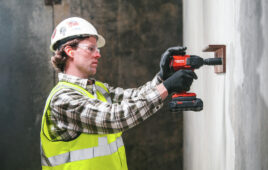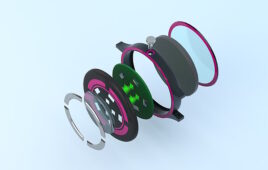By Julie Miller
Exceptional care is taken in choosing biocompatible adhesives — a category of adhesive products that are considered safe to use on or within the human body. These specialty adhesives are biologically inert, which means they produce no toxic response or interaction when in contact with human tissue or bodily fluids. Biocompatible adhesives are also used in veterinary applications.
Such adhesives are subjected to regulatory standards to confirm their compatibility. In general, the longer the adhesive is in contact with the biological environment, the more rigorous the testing protocol.
The two standard biocompatibility tests are:
- United States Pharmacopeia (USP) Class VI
- International Organization for Standardization (ISO) 10993

Bond strength of biocompatible adhesives by substrate. (Source: Master Bond)
In the United States, the Food and Drug Administration (FDA) requires that medical devices meet biocompatibility standards, and the adhesives are considered to be components of medical devices. No secondary FDA approval is needed for the adhesives, just the device itself. Adhesive suppliers are typically able to provide samples, technical support, and certificates of biocompatibility compliance for their products.
Other questions to ask include:
- What standard do you use for testing?
- How often are your products retested for compliance?
- How are test specimens prepared?
- What are the extraction conditions?
- Can you supply documentation to verify compliance?
One and two-part epoxy and silicone biocompatible adhesives are common choices. Other options include light-cured materials, epoxy-polyurethane blends, and cyanoacrylates.
The chemistries also vary in their resistance to sterilization techniques. For example, autoclaves produce high-pressure steam inside a chamber that might hold a temperature of 130° C (266° F) for 15 to 20 minutes to neutralize potentially infectious agents. Here, epoxies tend to have the widest application as they can endure repeated autoclaving, as well as chemical sterilization and gamma irradiation.
Sterilization requirements may increasingly figure into an engineer’s choice of adhesive with today’s greater demand for reusable sterile instruments such as surgical forceps, endoscopes, colonoscopes, and others. Additionally, disposable products that might require biocompatible adhesives include catheters, needles and syringes, and wearables. However, implanted medical devices, such as pacemakers, are unlikely to employ adhesives.
Medical-grade pressure sensitive adhesives are also widely available for wound care, diagnostic test strips, surgical drapes, and other applications. In this case, tack, adhesion, shear strength and breathability are considerations. The medical device industry is growing rapidly, particularly in the direct-to-consumer niche.
As more care is delivered outside of the hospital and physician office, high-performance devices will become more widely used in healthcare service. Quality and safety must be assured with the use of appropriate biocompatible adhesives.





Tell Us What You Think!